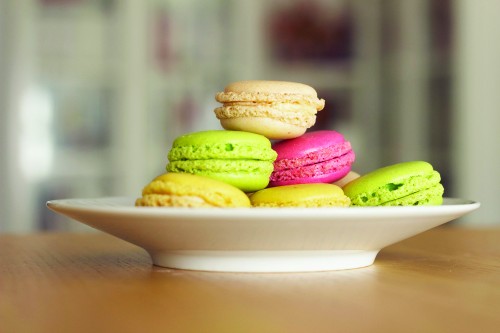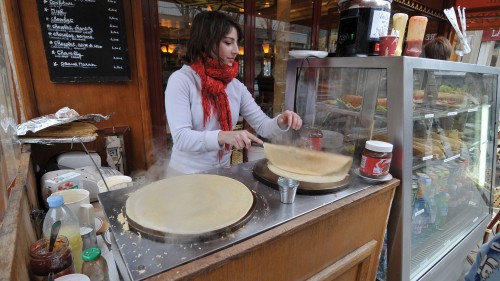Must-Have Foods to Try in France
When traveling, monuments and museums merely play a role in the decision making; food is an important contender as well. If the choice is between a one-time trip to Europe, a pizza lover may choose Italy over England, despite the language barrier. Humans need to eat, so why not enjoy foreign eating experiences to the […]
When traveling, monuments and museums merely play a role in the decision making; food is an important contender as well. If the choice is between a one-time trip to Europe, a pizza lover may choose Italy over England, despite the language barrier. Humans need to eat, so why not enjoy foreign eating experiences to the fullest? Diets are forgotten, “moderation” is a term which temporarily vanishes from ones vocabulary, and each meal is no longer about just eating, but viewing a culture through its most basic function.
Sure, the Eiffel Tower deserves some credit, maybe even the Mona Lisa, but tourists never look happier in Paris as when they are entering or exiting a bakery, café, or restaurant. During peak season, the lines at certain well-known sweet shops rival those of the Arc de Triomphe, the Madeleine, and the Opera. Generations of tourists have chosen France as their European destination, partly for the food. The lure of fresh-baked goods, elegantly presented dishes, and the array of unique cheeses and wines are enough to convince most travelers.
The French have an intense relationship with cuisine and every aspect that accompanies food. Over the centuries, so many French delicacies have been introduced in French culture that it is even hard for a French epicure to keep track. In order to get the most out of the culinary side of France in a short period of time, one must narrow down the list of the most typical and popular dishes in France. Over the years, I have made note of what I see being consumed, offered, praised, and recommended the most to foreigners. Here is the most refined list of the must-have foods while in France.

The Main Dishes
Boeuf Bourguignon: this is a savory dish good enough for any beef lover. The beef is usually served with a sauce consisting of flour, onions, carrots, garlic, mushrooms, thyme, red wine, oil, salt, and pepper. The mix of beef and vegetables can be eaten alone, like a type of stew, or with fries, or baked, or boiled potatoes. When served with potatoes, the meat is very bloody, with the sauce poured over it. The French enjoy their steaks rare, so when ordering this dish, or any dish with beef, specify how you would like your meat cooked.
Blanquette de Veau/Poulet: this recipe typically consists of veal, but in modern France chicken is just as common. In restaurants though, veal may be the only choice, since French chefs find substitutions offensive. The meat of choice is first soaked in the rich salty butter of the region of Brittany, then the meat is slowly cooked with onion, carrots, mushrooms, fresh cream, lemon juice, an egg, flour, white wine, and either a chicken or vegetable bouillon cube. When finished, the veal or chicken is accompanied by a rich, tasty sauce, served with rice.
Coq au Vin: this dish’s name might ring a bell, as it is one of the most mentioned French dishes in movies and is a common item on any elegant restaurant’s menu. This dish is actually similar to the Blanquette de Veau/Poulet, except that the original meat is chicken, rather than chicken being the substitute. The meat is slowly cooked with a mix consisting of flour, salt, pepper, oil, red wine, cognac, mushrooms, carrots, onion, and garlic. This recipe is versatile, allowing almost any mix of vegetables while still remaining delicious.
Crepes: it is impossible to visit France without sampling at least one type of crepe. Crepes are a national treasure in France, being rather easy to prepare, cheap, and good with most chosen ingredients, allowing chefs to really be creative. To start, there are the “salt crepes,” which simply refer to the non-sweet crepes. In France, there are four typical crepes.
1. The Complete, which consists of an egg, shredded Emmental cheese, ham, and salt.
2. The Complete Tomate, which consists of the same ingredients as the complete, except tomatoes are added.
3. The Shiitake crepe simply consists of shiitake mushrooms and fresh cream.
4. The Fruits de Mer, or Seafood crepe. This combination depends on the location, as well as personal taste. Typically, the ingredients offered are clams, crab, muscles, or lobster.
The sugar crepes are better known to foreigners, as is evident by their endless searches of chocolate crepes throughout the streets of Paris. There are four common sugar (or sweet) crepes in France:
1. The Beurre Sucre, or butter and sugar. As the name suggests, it consists of butter and sugar melted together in a crepe.
2. The Crepe Suzette, with sugar, lemon juice, and Grand Marnier liquor.
3. The Banane Chocolat-Chantilly, or banana chocolate crepe with whipped cream served on top. This simple crepe is made by melting chocolate in a crepe with slices of banana, then topping it off with whipped cream.
4. The Nutella Crepe, now considered one of the classic crepes in France, this simple crepe consists only of slightly melted Nutella. Simplicity at its finest!
The small, but important morsels of French Degustation
Foie Gras: despite the controversy surrounding duck liver, it is still widely enjoyed in France. However, this delicacy is not eaten often by the average French person. Most people only eat a small serving of it on Christmas Eve, Christmas Day, and New Year’s Eve. The preferred manner of consumption is with a warmed canapé, and caramelized red onions. If vacationing in France around the holiday season this will be a typical fixture in stores and restaurants.
Pâté: the French eat this little treat rather often, maybe four times a week or more. The idea of minced, chilled ground meat and fat in the form of a spread is off-putting for many Americans. But, the French cannot get enough, even though it is unhealthy. Pate is usually served with slices of baguette, or other freshly baked bread.
Baguette: self-explanatory and completely unavoidable is the delicious French bread. This is a fixture of French culture unlikely to go anywhere soon, as the young and old can still be seen making their morning, afternoon, and evening trips to the nearest bakery. A meal just isn’t complete without the baguette. No worries, they sell them in whole wheat form now!
The Desserts
Croissant: the renowned crescent-shaped baked good that the world has come to love. Sure, croissants are sold all over, but none can match the authentic taste of them fresh out of the oven of a French bakery. A pound of salted butter in every batch, these little goodies can be eaten with Nutella, jam, butter (yes, more butter), or even cheese. The French however, reserve croissants for breakfast with Nutella, butter, or jam.

Pain au Chocolat: this is one of my personal favorites. The pain au chocolat, or chocolate bread, is made much like a croissant, except that there are two pieces of chocolate added before baking, and the shape is a square rather than a crescent.
Pain aux Raisins: raisin bread. The title in English can be misleading, because these treats taste nothing like raisin bread one finds in the U. S. Instead it is a type of brioche, twisted to include cream and raisins.
Éclair: consumed in moderation even by the French due to the high caloric count, éclairs are like mini-long donuts, full of cream, and topped with a thin layer of caramel, chocolate, or café-flavored icing. Unlike the donut, the éclair is flaky, and lacking in grease.
Macaron: these are so famous and yummy that Japanese tourists will stop at nothing to find the best, and try every flavor while in Paris. These are a type of cookies typically filled with jams or creams, available in almost every flavor and color imaginable.
Asking a French person to narrow down the best types of cheese and wine in France is like asking one of them to choose a favorite limb; they simply cannot narrow the list down. I cannot speak for the French, and I do not claim to be a “connoisseur” of cheese or wine, but I have compiled a list of the most common cheeses and wine I’ve encountered in France. I hope this will help some of the overwhelmed tourists when the time comes to make a decision. Of course, the consumption of wine is always optional, and is advised to be consumed in moderation.
The Cheeses
Chèvre
Camembert
Brie
Rocquefort
Bleu de Bresse
The Wines
Bordeaux (red)
Merlot (red)
Chateauneuf du Pape (red)
Loupiac (white)
Sauvignon (white)
Chardonnay (white)

A trip to France wouldn’t be complete without trying at least one of the main dishes, deserts, cheeses, and wines. Humans subconsciously allow their appetites to make important decisions for them, such as where to go on vacation. Luckily, there is plenty of good food in France to satisfy any food-related travel requirements. Knowing what France has to offer is key to a great food experience. Being aware of the many options before embarking will help eliminate stress brought on by too many choices.
Jacqueline Perrier-Gillette is currently a resident of Paris, France, where she lives with her husband. Together the two of them operate their small translation company, giving Jacqueline the opportunity to observe the French and their culture up close. She is an avid reader, writer, and student of foreign languages.
By Jacqueline Perrier-Gillette





